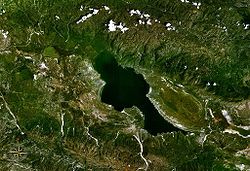Étang Saumâtre
Étang Saumâtre (in English, brackish pond) is the largest lake of Haiti. It is the second largest lake of Hispaniola, after Lake Enriquillo. It is also known as Lake Azuei. It is known as Lago del Fondo in the Dominican Republic. Its Taíno name was Yainagua.[1]
| Étang Saumâtre | |
|---|---|
| Location | Plaine du Cul-de-Sac |
| Coordinates | 18°35′51″N 72°00′53″W / 18.59750°N 72.01472°WCoordinates: 18°35′51″N 72°00′53″W / 18.59750°N 72.01472°W |
| Lake type | Salt lake |
| Basin countries | Haiti Dominican Republic |
| Max. length | 29 km (18 mi) |
| Max. width | 9.7 km (6.0 mi) |
| Surface area | 170 km2 (66 sq mi) |
The lake is on the arid part of the Plain of the Cul-de-Sac. It is 29 kilometres (18 mi) east of Port-au-Prince in the Ouest Department.[2] Its eastern side is part of the border between Haiti and the Dominican Republic; the Dominican city of Jimaní is at less than 1 km from the southeast end of the lake.
The salt-water lake has a length, from northwest to southeast, of 22 kilometres (14 miles). Its maximum width is 12 kilometres (7.5 miles). The total area is 170 square kilometres (66 square miles).[2]
The water of the lake is dark blue. Its salinity is about one fifth (1/5) the salinity of sea water.[2] Very few small rivers flow into the lake.
Many water birds visit the lake to feed, including flamingos. There are also American crocodiles and some fishes including tilapia.[3] Because it is an arid region, the vegetation around the lake is poor with cacti and small shrubs.
Étang Saumâtre Media
References
| Wikimedia Commons has media related to Lua error in Module:Commons_link at line 62: attempt to index field 'wikibase' (a nil value).. |
- ↑ Anglería, Pedro Martir de (1964). Décadas (in Spanish). Mexico: José Porrúa e Hijos.
{{cite book}}: CS1 maint: unrecognized language (link) - ↑ 2.0 2.1 2.2 Pierre, Marie Gisèle (1980). "Les Eaux Dormantes de la République d'Haïti". : 162Port-au-Prince: Université d'État d'Haïti.
- ↑ "Aquaculture development in the Caribbean". Food and Agriculture Organization (FAO). Retrieved 2009-10-10.




